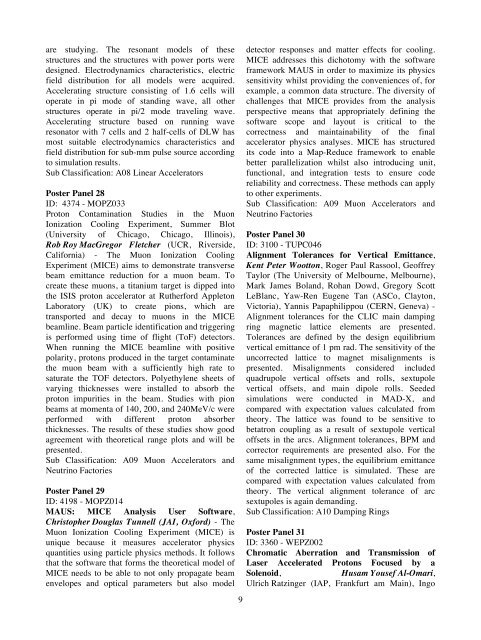Abstracts Brochure - 2nd International Particle Accelerator Conference
Abstracts Brochure - 2nd International Particle Accelerator Conference
Abstracts Brochure - 2nd International Particle Accelerator Conference
Create successful ePaper yourself
Turn your PDF publications into a flip-book with our unique Google optimized e-Paper software.
are studying. The resonant models of these<br />
structures and the structures with power ports were<br />
designed. Electrodynamics characteristics, electric<br />
field distribution for all models were acquired.<br />
Accelerating structure consisting of 1.6 cells will<br />
operate in pi mode of standing wave, all other<br />
structures operate in pi/2 mode traveling wave.<br />
Accelerating structure based on running wave<br />
resonator with 7 cells and 2 half-cells of DLW has<br />
most suitable electrodynamics characteristics and<br />
field distribution for sub-mm pulse source according<br />
to simulation results.<br />
Sub Classification: A08 Linear <strong>Accelerator</strong>s<br />
Poster Panel 28<br />
ID: 4374 - MOPZ033<br />
Proton Contamination Studies in the Muon<br />
Ionization Cooling Experiment, Summer Blot<br />
(University of Chicago, Chicago, Illinois),<br />
Rob Roy MacGregor Fletcher (UCR, Riverside,<br />
California) - The Muon Ionization Cooling<br />
Experiment (MICE) aims to demonstrate transverse<br />
beam emittance reduction for a muon beam. To<br />
create these muons, a titanium target is dipped into<br />
the ISIS proton accelerator at Rutherford Appleton<br />
Laboratory (UK) to create pions, which are<br />
transported and decay to muons in the MICE<br />
beamline. Beam particle identification and triggering<br />
is performed using time of flight (ToF) detectors.<br />
When running the MICE beamline with positive<br />
polarity, protons produced in the target contaminate<br />
the muon beam with a sufficiently high rate to<br />
saturate the TOF detectors. Polyethylene sheets of<br />
varying thicknesses were installed to absorb the<br />
proton impurities in the beam. Studies with pion<br />
beams at momenta of 140, 200, and 240MeV/c were<br />
performed with different proton absorber<br />
thicknesses. The results of these studies show good<br />
agreement with theoretical range plots and will be<br />
presented.<br />
Sub Classification: A09 Muon <strong>Accelerator</strong>s and<br />
Neutrino Factories<br />
Poster Panel 29<br />
ID: 4198 - MOPZ014<br />
MAUS: MICE Analysis User Software,<br />
Christopher Douglas Tunnell (JAI, Oxford) - The<br />
Muon Ionization Cooling Experiment (MICE) is<br />
unique because it measures accelerator physics<br />
quantities using particle physics methods. It follows<br />
that the software that forms the theoretical model of<br />
MICE needs to be able to not only propagate beam<br />
envelopes and optical parameters but also model<br />
�<br />
9<br />
detector responses and matter effects for cooling.<br />
MICE addresses this dichotomy with the software<br />
framework MAUS in order to maximize its physics<br />
sensitivity whilst providing the conveniences of, for<br />
example, a common data structure. The diversity of<br />
challenges that MICE provides from the analysis<br />
perspective means that appropriately defining the<br />
software scope and layout is critical to the<br />
correctness and maintainability of the final<br />
accelerator physics analyses. MICE has structured<br />
its code into a Map-Reduce framework to enable<br />
better parallelization whilst also introducing unit,<br />
functional, and integration tests to ensure code<br />
reliability and correctness. These methods can apply<br />
to other experiments.<br />
Sub Classification: A09 Muon <strong>Accelerator</strong>s and<br />
Neutrino Factories<br />
Poster Panel 30<br />
ID: 3100 - TUPC046<br />
Alignment Tolerances for Vertical Emittance,<br />
Kent Peter Wootton, Roger Paul Rassool, Geoffrey<br />
Taylor (The University of Melbourne, Melbourne),<br />
Mark James Boland, Rohan Dowd, Gregory Scott<br />
LeBlanc, Yaw-Ren Eugene Tan (ASCo, Clayton,<br />
Victoria), Yannis Papaphilippou (CERN, Geneva) -<br />
Alignment tolerances for the CLIC main damping<br />
ring magnetic lattice elements are presented.<br />
Tolerances are defined by the design equilibrium<br />
vertical emittance of 1 pm rad. The sensitivity of the<br />
uncorrected lattice to magnet misalignments is<br />
presented. Misalignments considered included<br />
quadrupole vertical offsets and rolls, sextupole<br />
vertical offsets, and main dipole rolls. Seeded<br />
simulations were conducted in MAD-X, and<br />
compared with expectation values calculated from<br />
theory. The lattice was found to be sensitive to<br />
betatron coupling as a result of sextupole vertical<br />
offsets in the arcs. Alignment tolerances, BPM and<br />
corrector requirements are presented also. For the<br />
same misalignment types, the equilibrium emittance<br />
of the corrected lattice is simulated. These are<br />
compared with expectation values calculated from<br />
theory. The vertical alignment tolerance of arc<br />
sextupoles is again demanding.<br />
Sub Classification: A10 Damping Rings<br />
Poster Panel 31<br />
ID: 3360 - WEPZ002<br />
Chromatic Aberration and Transmission of<br />
Laser Accelerated Protons Focused by a<br />
Solenoid, Husam Yousef Al-Omari,<br />
Ulrich Ratzinger (IAP, Frankfurt am Main), Ingo


